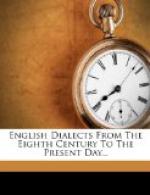It is impossible to mention even a tithe of the names of our better dialect writers. In Scotland alone there is a large number, some of the more recent bearing such well-known names as those of R.L. Stevenson, George Macdonald (Aberdeen), J.M. Barrie (Forfarshire), and S.R. Crockett (Galloway). Dean Ramsay’s humorous Reminiscences of Scottish Life and Character must not be passed over. For Ireland we have William Carleton’s Traits and Stories of the Irish Peasantry, and the novels by Lever and Lover. Cumberland has its delightful stories of Joe and the Geologist, and Bobby Banks’ Bodderment. Cornwall has its Tales, by J.T. Tregellas. Devon can boast of R.D. Blackmore, Dorset of Hardy and Barnes, and Lincoln of Tennyson. The literature of Lancashire is vast; it suffices to mention John Collier (otherwise Tim Bobbin), author of Tummus and Meary, Ben Brierley, John Byrom, J.P. Morris, author of T’ Lebby Beck Dobby, and Edwin Waugh, prose author and poet. Giles’s Trip to London, and the other sketches by the same author, are highly characteristic of Norfolk. Northamptonshire has its poet, John Clare; and Suffolk can boast of Robert Bloomfield. According to her own statement, printed in the Preface (p. viii) to the E.D.S. Bibliographical List, George Eliot, when writing Adam Bede, had in mind “the talk of N. Staffordshire and the neighbouring part of Derbyshire”; whilst, in Silas Marner, “the district imagined is in N. Warwickshire.” Southey wrote T’ Terrible Knitters e’ Dent in the Westmoreland dialect. Yorkshire, like Lancashire, has a large literature, to which the E.D.D. Booklist can alone do justice.
SCOTTISH (Group 3): ABERDEEN.
The following extract is from Chapter XVIII of Johnny Gibb of Gushetneuk, by W. Alexander, LL.D., fifteenth edition, Edinburgh, 1908. One special peculiarity of the dialect is the use of f for wh, as in fat, what, fan, when. The extract describes how the speaker and his friends went to hear a bellman make a proclamation about the appointment of a new minister to a church.
It’s a vera stiff brae, an’ ere we wan up to the kirk, it was gyaun upon eleyven o’clock. “Hooever,” says the mannie, “we’ll be in braw time; it’s twal ere the sattlement begin, an’ I’se warran they sanna apen the kirk-doors till’s till than.” So we tak’s a luik roun’ for ony kent fowk. They war stannin’ aboot a’gate roun’ aboot the kirk, in scores an’ hunners, fowk fae a’ the pairis’es roun’ aboot, an’ some fae hyne awa’ as far doon’s Marnoch o’ the tae han’ an’ Kintore o’ the tither, aw believe; some war stampin’ their feet an’ slappin’ their airms like the yauws o’ a win’mill to keep them a-heat; puckles wus sittin’ o’ the kirk-yard dyke, smokin’ an’ gyaun on wi’ a’ kin’ o’ orra jaw aboot the minaisters, an’ aye mair gedderin’ in aboot—it was thocht there wus weel




